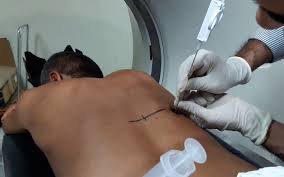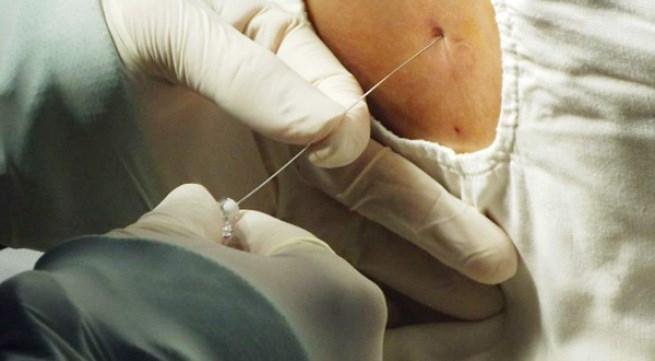Lung/pleural biopsy under computed tomography
This article is professionally consulted by Master, Resident Doctor Tran Duc Tuan - Department of Diagnostic Imaging - Vinmec Central Park International General Hospital. The doctor has many years of experience in the field of imaging and interventional internal and external blood vessels.
Lung/pleural biopsy under computed tomography is a minimally invasive, safe and highly accurate diagnostic technique. This technique is often indicated when the patient is suspected of having tumor, inflammation, tuberculosis in the lung, pleura and mediastinum.
1. What is lung biopsy technique, pleural biopsy under computed tomography?
Computed tomography-guided lung biopsy/pleural biopsy is a technique that uses a biopsy needle through the chest wall to obtain a specimen from the lesion for cytology and histopathology. The process is performed under the guidance and control of computed tomography.
Conventional imaging techniques such as chest X-ray and computed tomography (CT) scan of the chest can help detect lung lesions, but to confirm the nature of the lesion, images are often not enough. Using a needle for a CT-guided transthoracic biopsy provides more information for diagnosis. This is a safe, minimally invasive technique that gives accurate diagnostic results.
Lung / pleural biopsy under the guidance of computed tomography is often indicated in cases of lung, pleural and mediastinal lesions that need to confirm the diagnosis, suspect tumor lesions, inflammation, or tuberculosis. ..
Conventional imaging techniques such as chest X-ray and computed tomography (CT) scan of the chest can help detect lung lesions, but to confirm the nature of the lesion, images are often not enough. Using a needle for a CT-guided transthoracic biopsy provides more information for diagnosis. This is a safe, minimally invasive technique that gives accurate diagnostic results.
Lung / pleural biopsy under the guidance of computed tomography is often indicated in cases of lung, pleural and mediastinal lesions that need to confirm the diagnosis, suspect tumor lesions, inflammation, or tuberculosis. ..

Sinh thiết phổi cho phép xét nghiệm tế bào và mô bệnh học
2. What to prepare before performing lung biopsy, pleural biopsy under computed tomography?
2.1. The person performing the trick
The team performing the transthoracic biopsy under the guidance of CT includes a specialist, an assistant doctor, a nurse, an electro-optical technician. If the patient cannot cooperate, the team also needs the support of the doctor and anesthesiologist.
2.2. Means of performing CT-guided transthoracic biopsy
Necessary facilities to perform lung biopsy / pleural biopsy under computed tomography include:
Computerized tomography machine; film, film printer, image storage system Local anesthetic, general anesthetic (if there is an indication for anesthesia), water-soluble iodinated contrast agent, skin antiseptic solution Biopsy needle specialized, needle pump, cotton, gauze,...
Computerized tomography machine; film, film printer, image storage system Local anesthetic, general anesthetic (if there is an indication for anesthesia), water-soluble iodinated contrast agent, skin antiseptic solution Biopsy needle specialized, needle pump, cotton, gauze,...
2.3. Prepare patient for CT-guided transthoracic biopsy
Before performing the technique, the patient and family members will be explained by the medical staff the purpose, steps and possible risks. Biopsy is performed only if the patient consents and signs the consent form for the procedure.
Patients will be carried out a number of important tests such as blood count test, complete coagulation test, echocardiogram, ECG, respiratory function measurement, ... to ensure health conditions. suitable for performing biopsies.
The medical staff will instruct the patient to fast for 4 hours before the lung biopsy / pleural biopsy. The patient must inform the doctor of all the medicines they are taking, the drugs that are allergic,... The doctor will ask to stop the anticoagulants, antiplatelet drugs (such as Heparin, Aspirin, etc.) Wafarin,...) a few days before the procedure.
Female patient, if pregnant or suspected to be pregnant, must notify the doctor or technician in the imaging room. To avoid radiation exposure to the fetus, imaging methods are not usually performed. However, where it is necessary to proceed, precautions will be taken to minimize the potential for fetal exposure. Patients should also inform their doctor of other illnesses or health conditions, if any.
Patients will be carried out a number of important tests such as blood count test, complete coagulation test, echocardiogram, ECG, respiratory function measurement, ... to ensure health conditions. suitable for performing biopsies.
The medical staff will instruct the patient to fast for 4 hours before the lung biopsy / pleural biopsy. The patient must inform the doctor of all the medicines they are taking, the drugs that are allergic,... The doctor will ask to stop the anticoagulants, antiplatelet drugs (such as Heparin, Aspirin, etc.) Wafarin,...) a few days before the procedure.
Female patient, if pregnant or suspected to be pregnant, must notify the doctor or technician in the imaging room. To avoid radiation exposure to the fetus, imaging methods are not usually performed. However, where it is necessary to proceed, precautions will be taken to minimize the potential for fetal exposure. Patients should also inform their doctor of other illnesses or health conditions, if any.

Bệnh nhân trước khi sinh thiết cần xét nghiệm ECG
3. How is a lung/pleural biopsy under computed tomography done?
The team instructs the patient to lie on the bed, then installs a machine to monitor breathing, pulse, blood pressure, electrocardiogram, and SpO2. The doctor may prescribe sedation if the excited patient does not lie still.
Localized CT scan for the patient to locate the lesion. After determining the location, the skin belonging to this location and the surrounding skin will be disinfected and cleaned. A towel that has been sterile and has a circular opening is placed over the disinfected skin area.
Apply local anesthetic around the area to be examined. The doctor will make a very small incision in the skin with a surgical blade, then insert a guide needle through the skin incision site under the guidance of computed tomography to bring the needle close to the site of the lesion (tumor). ).
A specialized biopsy needle will be passed through the guide needle to reach the tumor. The doctor will conduct a biopsy cutting into the tumor, taking 2-3 samples from different directions. Because when the patient breathes, the tumor will move with the breathing, so the patient should try to hold their breath while the needle is inserted through the pleura, lung parenchyma and during the biopsy.
Localized CT scan for the patient to locate the lesion. After determining the location, the skin belonging to this location and the surrounding skin will be disinfected and cleaned. A towel that has been sterile and has a circular opening is placed over the disinfected skin area.
Apply local anesthetic around the area to be examined. The doctor will make a very small incision in the skin with a surgical blade, then insert a guide needle through the skin incision site under the guidance of computed tomography to bring the needle close to the site of the lesion (tumor). ).
A specialized biopsy needle will be passed through the guide needle to reach the tumor. The doctor will conduct a biopsy cutting into the tumor, taking 2-3 samples from different directions. Because when the patient breathes, the tumor will move with the breathing, so the patient should try to hold their breath while the needle is inserted through the pleura, lung parenchyma and during the biopsy.

Bác sĩ sẽ tiến hành sinh thiết cắt vào khối u
After taking the specimen, the doctor will remove the biopsy needle and guide needle. The nurse disinfects and bandages the puncture site. Specimens will be fixed with absolute alcohol for cytology.
The team takes several cuts through the biopsy area to check if the patient has conditions such as bleeding in the lungs, pleura, pneumothorax,... or not.
The procedure is usually completed within an hour. The patient is instructed to stay in bed for at least 6 hours, the pulse, blood pressure, and general condition of the patient will be closely monitored for 24 hours after the procedure.
The team takes several cuts through the biopsy area to check if the patient has conditions such as bleeding in the lungs, pleura, pneumothorax,... or not.
The procedure is usually completed within an hour. The patient is instructed to stay in bed for at least 6 hours, the pulse, blood pressure, and general condition of the patient will be closely monitored for 24 hours after the procedure.
4. Possible complications in lung/pleural biopsy under computed tomography
4.1. Complications of pneumothorax
Complications of pneumothorax after specimen collection often occur in elderly patients; the patient has a thin body, thin chest wall; have COPD ; If the patient has a small degree of pneumothorax, it will go away on its own, and if there is a lot of pneumothorax, it is necessary to drain the pleura for the patient.

Người bệnh có thể bị tràn khí màng phổi khi thực hiện thủ thuật
4.2. Accident bleeding into the mouth, nose; coughing up blood during lung biopsy, pleural biopsy
Because the lung is a structure with a lot of important blood vessels such as pulmonary artery, bronchial artery, pulmonary vein, ... When performing a biopsy, the blood vessels can be cut, causing blood to flow into the alveoli. bronchi and then out the trachea, out the mouth or out the nose. Bleeding complications are common in elderly patients, patients are cut many specimens; Using a biopsy needle with a large diameter, ..The treatment depends on the degree of bleeding, if the patient has a small amount of bleeding, they will be monitored. If bleeding is heavy, use hemostatic drugs, blood transfusion,...
Some other possible complications such as bleeding lung parenchyma, severe pleura, chest pain, damage to the diaphragm and organs under the diaphragm, chest wall, ... The doctor will treat depending on symptoms and specific causes. Therefore, you should choose a lung biopsy at a large, reputable medical facility not only in the hospital system in general but also stand out and be a leader in the field of lung cancer diagnosis and treatment.
Some other possible complications such as bleeding lung parenchyma, severe pleura, chest pain, damage to the diaphragm and organs under the diaphragm, chest wall, ... The doctor will treat depending on symptoms and specific causes. Therefore, you should choose a lung biopsy at a large, reputable medical facility not only in the hospital system in general but also stand out and be a leader in the field of lung cancer diagnosis and treatment.
Để đặt lịch khám tại viện, Quý khách vui lòng bấm số HOTLINE hoặc đặt lịch trực tiếp TẠI ĐÂY. Tải và đặt lịch khám tự động trên ứng dụng MyVinmec để quản lý, theo dõi lịch và đặt hẹn mọi lúc mọi nơi ngay trên ứng dụng.






